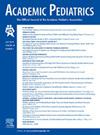Feasibility, Acceptability, and Appropriateness of Screening and Referring for Social Risks in a Community Hospital Setting
IF 2.8
3区 医学
Q1 PEDIATRICS
引用次数: 0
Abstract
Objective
In response to American Academy of Pediatrics and Centers for Medicare & Medicaid Services recommendations, a growing number of hospitals are implementing inpatient social care systems, but nearly all pediatric studies to date have been conducted in children’s hospitals. In 2022, a university–affiliated community hospital implemented a pediatric inpatient social risk screening and referral system. We aimed to assess the feasibility, acceptability, and appropriateness of this system in the community hospital setting.
Methods
We used a concurrent mixed methods approach from March to December 2023, surveying parents of hospitalized children and clinicians who perform or respond to screening, to assess implementation outcomes—feasibility, acceptability, and appropriateness—using validated measures based on 5-point Likert scales. We concurrently performed semistructured interviews assessing clinician and parent experiences with implementation and performed a thematic analysis.
Results
Forty-three parents (67%) and 31 clinicians (78%) completed surveys, and 20 interviews (11 parents and 9 clinicians) were performed. Among parents and clinicians, respectively, 95% and 97% rated implementation as feasible, 97% and 93% as acceptable, and 95% and 97% as appropriate. Interview themes emerged regarding feasibility: 1) community/hospital resources enable social care, 2) challenging limitations in social service personnel; acceptability: 1) value added to inpatient care, 2) positive impact on families’ health, 3) inadequate expectation-setting concerns; and appropriateness: 1) natural fit within workflows, 2) desire for different modality/timing options.
Conclusions
Implementation of a pediatric inpatient social care system was feasible, acceptable, and appropriate in a community hospital setting; however, challenges and key areas for improvement were identified that can serve as leverage points for future implementation strategies.
社区医院社会风险筛查和转诊的可行性、可接受性和适当性。
目的:为了响应AAP和CMS的建议,越来越多的医院正在实施住院社会护理系统,但迄今为止几乎所有的儿科研究都是在儿童医院进行的。2022年,某大学附属社区医院实施儿科住院患者社会风险筛查和转诊系统。我们旨在评估该系统在社区医院环境中的可行性、可接受性和适宜性。方法:从2023年3月至12月,我们采用并行混合方法,调查住院儿童的父母和实施或响应筛查的临床医生,以评估实施结果的可行性、可接受性和适当性,使用基于5点李克特量表的有效措施。我们同时进行了半结构化访谈,评估临床医生和家长在实施过程中的经验,并进行了主题分析。结果:43名家长(67%)和31名临床医生(78%)完成了问卷调查,进行了20次访谈(11名家长,9名临床医生)。在家长和临床医生中,分别有95%和97%的人认为实施是可行的,97%和93%的人认为可以接受,95%和97%的人认为适当。访谈主题涉及可行性:(一)社区/医院资源使社会护理成为可能;(二)挑战社会服务人员的局限性;可接受性:(一)增加住院治疗的价值;(二)对家庭健康的积极影响;(三)设定期望不足的关切;适当性:(i)与工作流程的自然契合,(ii)对不同模式/时间选择的渴望。结论:在社区医院实施儿科住院患者社会护理系统是可行的、可接受的和适当的;然而,我们确定了挑战和需要改进的关键领域,可以作为未来实施战略的杠杆点。
本文章由计算机程序翻译,如有差异,请以英文原文为准。
求助全文
约1分钟内获得全文
求助全文
来源期刊

Academic Pediatrics
PEDIATRICS-
CiteScore
4.60
自引率
12.90%
发文量
300
审稿时长
60 days
期刊介绍:
Academic Pediatrics, the official journal of the Academic Pediatric Association, is a peer-reviewed publication whose purpose is to strengthen the research and educational base of academic general pediatrics. The journal provides leadership in pediatric education, research, patient care and advocacy. Content areas include pediatric education, emergency medicine, injury, abuse, behavioral pediatrics, holistic medicine, child health services and health policy,and the environment. The journal provides an active forum for the presentation of pediatric educational research in diverse settings, involving medical students, residents, fellows, and practicing professionals. The journal also emphasizes important research relating to the quality of child health care, health care policy, and the organization of child health services. It also includes systematic reviews of primary care interventions and important methodologic papers to aid research in child health and education.
 求助内容:
求助内容: 应助结果提醒方式:
应助结果提醒方式:


